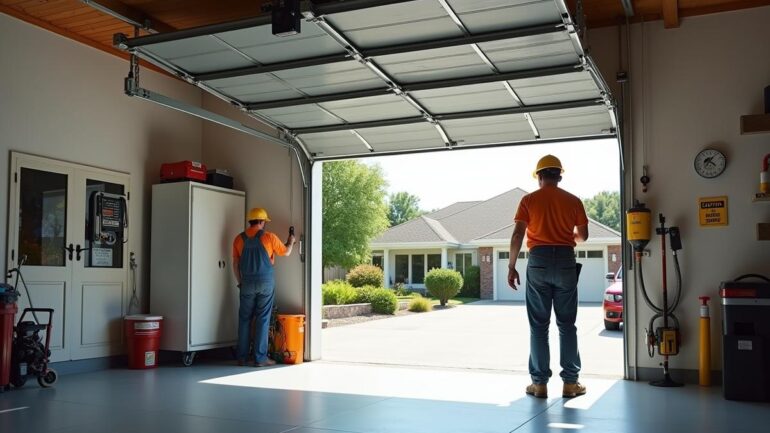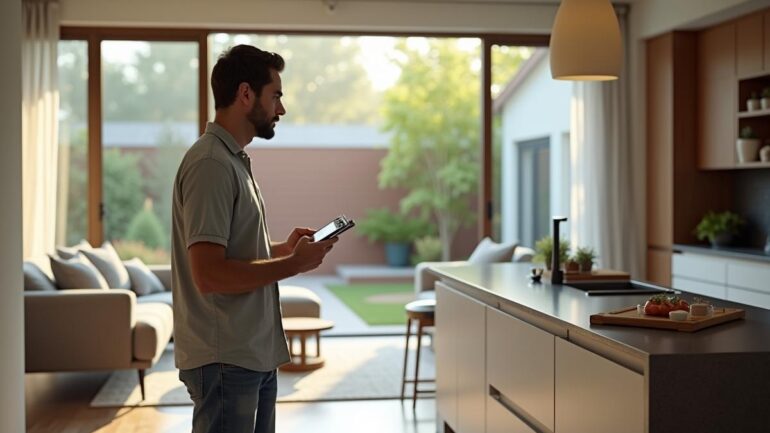Understanding the basics of safety is vital for every household with a garage door. We often rely on our garage doors daily without considering how a minor issue can lead to major problems or potential injuries. By taking a few proactive steps, you can minimize risks, uphold child safety, and extend the life of your doors. Below, you’ll find key practices to help ensure everything runs smoothly while reducing the chance of preventing accidents.
The Impact of Regular Garage Door Maintenance
Routine care and timely repairs are crucial if you want reliable performance for years to come. Paying attention to suspicious sounds, uneven operation, or worn-out parts can help you detect potential hazards before they escalate. This not only protects your family but also saves money in the long run by avoiding expensive fixes.
Proper garage door maintenance includes examining cables, tracks, and springs. Regular lubrication of moving parts, paired with occasional garage door inspections, ensures safe operation. Inspect the surface for rust, corrosion, or warping due to humidity changes, and replace any compromised garage door hardware swiftly.
Checking Springs, Tracks, and More
Springs and cables under tension can cause serious harm if they break unexpectedly. It’s smart to check their condition and tension balance on a routine basis. Meanwhile, tracks that are bent or clogged with debris could prevent the door from moving smoothly, so a quick wipe-down helps reduce friction.
Keeping your door well-aligned means preventing uneven stress on the system. If you’re in doubt about a repair, consult a qualified technician who holds safety certifications to ensure everything is done correctly.
Safeguarding Kids and Pets
Children and pets can be especially vulnerable around moving doors. A misaligned track or defunct safety sensor could result in painful accidents, so set ground rules for youngsters and remind them not to run under the door while it’s closing.
Think about adding bright caution stickers as visual reminders to discourage little ones from touching the tracks or playing near the hardware. Placing your garage door opener safety button high enough so younger children cannot reach it is another essential step.
Why Child Safety Depends on Clear Guidelines
Little ones need consistent reminders of what’s okay to touch and what’s off-limits. Demonstrate how the door moves and emphasize that they should never try to race underneath it. If your opener includes a lock feature, use it whenever you won’t be around to supervise.
Games and role-play can teach kids about garage door security in a fun, memorable way. When the door is treated with respect, it adds a layer of home security by reducing the chance of injuries or damage.
Verifying Automatic Reverse Mechanisms and Door Opener Safety
Modern garage door technology often comes with an automatic reverse mechanism that retracts the door if it senses an obstacle. Regular testing ensures it works as intended, and all you need is a small object placed in the door’s path. If the door doesn’t reverse immediately, it’s time to investigate further.
Keep an eye on the door’s reaction when it meets resistance. If you notice any delay, schedule a thorough check-up, especially if you haven’t performed one in a while. Pair your testing with proper door opener safety practices to prevent unwanted surprises.
Using the Emergency Release Properly
Knowing how to use the emergency release handle could save you valuable time if there’s a power outage or mechanical failure. This handle disconnects the door from the opener, allowing you to manually lift or lower the panel.
Never pull the release when the door is fully open or in motion, since it may slam shut under the weight of the panels. Before engaging the mechanism again, make sure the door is balanced and ready for normal operation.
Home Security and Fire Safety Considerations
Besides safeguarding your family against physical harm, a secure garage door also protects against break-ins. Simple tasks, such as regularly checking the lock function and ensuring the remote control is secure, can deter potential intruders. Emphasize home security by confirming your door closes fully, with no gaps that someone could exploit.
Fire safety is another critical element. Some garages store flammable materials, so a well-maintained door can help slow the spread of flames in an emergency. Look for weather stripping that seals off the perimeter, enhancing both fire safety and temperature control. This seal also shields the interior from dust, insects, and humidity that deteriorate the door’s condition over time.
Enhancing Safety with Weather Stripping
Weather stripping helps keep out moisture, debris, and insects. Over time, worn edges or compromised seals can weaken the door’s overall efficiency. Replacing them is relatively simple and contributes to better insulation and fewer energy expenses.
Adding ultraviolet protection on windows or panels can guard your door against sun damage. This protective measure ensures your paint or finish doesn’t peel prematurely, keeping it looking fresh and structurally sound.
Keeping Hardware in Top Shape
Hidden components, such as brackets and rollers, can loosen or wear down without proper maintenance tips. Inspect them occasionally, especially if your door starts making unfamiliar noises. It’s also wise to ensure the door runs smoothly along the track from open to shut without jerking or shaking.
If you do spot any hardware issues, address them promptly to avoid future complications. Simple fixes, such as tightening bolts or adjusting the tracks, can preserve the system. More serious problems like broken springs usually require professional assistance, so don’t attempt major repairs on your own.
A Look at Garage Door Safety Certifications
Manufacturers often subject their products to strict testing. Check if your system comes with recognized certifications that meet local safety guidelines. This could include official stamps verifying the door’s durability and performance during regular use.
If you’re looking into new installations, research garage door technology innovations that feature advanced sensors and remote control safety measures. These extras add convenience and give you peace of mind, knowing you’ve invested in a secure system.
Assessing Remote Control Safety and Preventing Accidents
Leaving remote controls in the car can be inviting for thieves, especially if they peek into windows. Keep the remote hidden or store it in your bag, so it’s out of sight when leaving your vehicle. Updating your system to rolling codes can also help protect your home from potential hackers.
Take time to understand how your door responds to the remote. If its range seems inconsistent or it struggles to open, check for interference from nearby electronics. If nothing resolves the issue, it might be time to upgrade to a modern device with stronger signals and improved entrance safety.
Weather Concerns and Ultraviolet Protection
Extremes in temperature, along with constant sunshine, can weaken door panels. If you live in a region with harsh weather, an extra layer of ultraviolet protection and regular painting or sealing can keep your door in strong shape. A sturdy finish helps preventing accidents by maintaining the door’s structural integrity.
Don’t neglect the tracks or garage door sensors when dealing with heat or cold. Conduct seasonal inspections to ensure debris buildup, ice, or rust hasn’t interfered with the door’s performance. These small checks let you address issues before they evolve into more significant challenges.
Creating a Routine Garage Door Safety Checklist
Get into the habit of checking your door every couple of weeks. Focus on the balance, smoothness of operation, overall cleanliness, and any unusual sounds. These simple acts can reveal early signs of wear or potential malfunctions on safety beams for garage doors.
If you spot anything out of the ordinary, schedule a professional visit. Many technicians offer garage door safety inspections that include advanced testing of the door’s balance, track stability, and sensor accuracy. Acting fast can prevent injuries and guarantee a tougher defense against forced entry.
Balancing Your Door and Optimizing Performance
A balanced door is simpler to lift and places less strain on the opener. Disconnect your opener and manually lift the door to see if it stays in position. If it slips down, your springs might need adjustment.
Staying vigilant strengthens overall garage door security. Lightweight movements, well-lubricated parts, and fully functioning garage door safety features create a safer environment for everyone in the household.
Embracing a Safer Home Environment
Staying on top of small fixes and routine tune-ups can extend your door’s lifespan. It also prevents surprise breakdowns that could trap cars inside or leave your garage open to intruders. A consistent approach to garage door repair keeps your investment worth every penny.
You can improve entrance safety dramatically with quick monthly checkups and responsible use of the remote control safety features. Taking action now helps avoid the stress of sudden malfunctions and ensures your system is well-equipped to handle day-to-day wear. With an eye on each component—sensors, springs, cables, and beyond—you’ll keep loved ones and possessions out of harm’s way.





